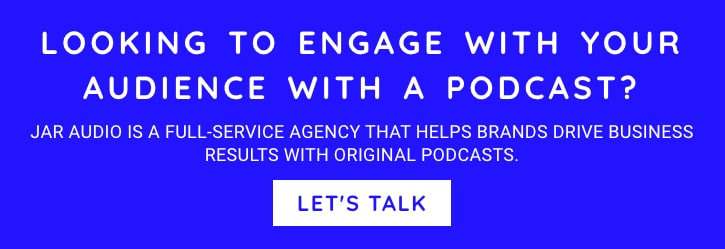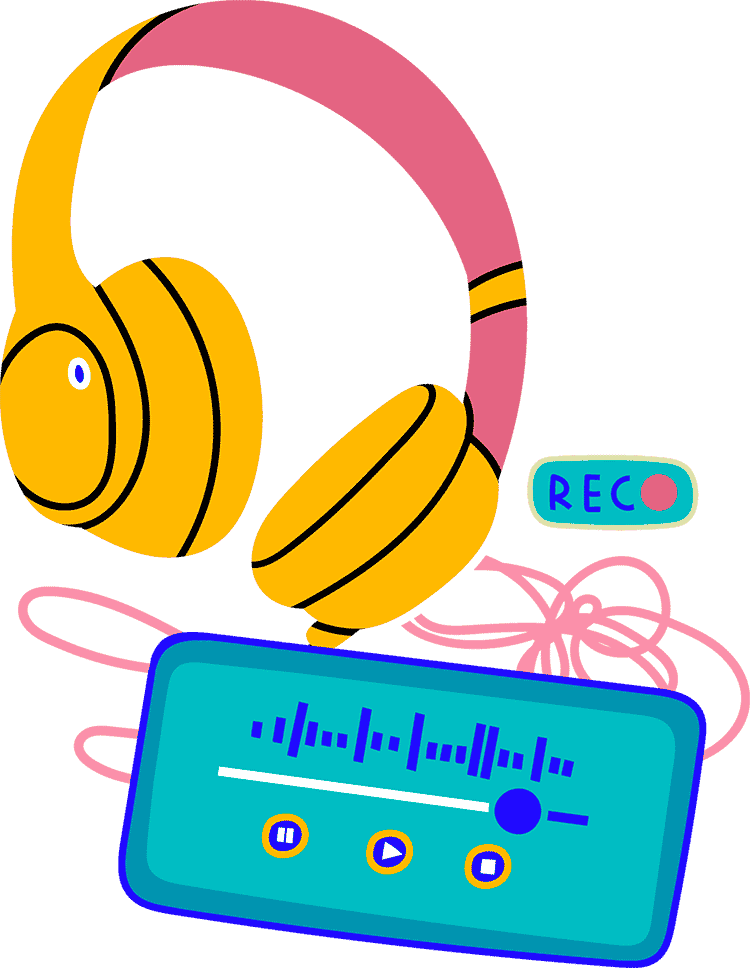Hint: Could It Be the Creative?
They’ve barely hit play, but your audience is already making a call: skip it, save it, or share it. What tips the scale?
It’s 8:12 a.m. and the train is late again. Maya scrolls through her podcast feed, thumb flicking past cover art and half-read titles. She’s not looking for specific information. She wants something that makes her feel something. Something that doesn’t sound like it was made by a committee.
She tries one. The title promised insight. But 30 seconds in, it’s clear: generic host, vague setup, nothing urgent to say. Feels like those work meetings that drone on and on. Skip.
Then she hits play on another. This time, the voice is sharp, confident. The first line grabs her with a question she didn’t know she needed answered. She laughs. She listens. She sends it to her team with a note: “This is what I meant yesterday in the meeting.”
That’s the difference good creative makes. Not in the abstract, but in the gut.
At JAR Audio, we see this all the time. We make branded podcasts that punch above their weight because they start with real creative planning — not sleek strategy decks. We ask: Who is this podcast really for? What are they hungry for? And how can we deliver it in a way that feels human and entertaining, not just benignly helpful?
Podcasts have to earn audience attention – or “share of ear.”
Here are a few of the ways to do that:
1. A Smart Title That Earns the Click
Your title isn’t just the cherry on top. It’s the bait. Consider Nice Genes, our podcast with Genome BC. The show’s name itself is playful, punchy, and scientifically smart — a rare blend that instantly signals you’re in for something surprising and engaging.
Episodes like “Bananageddon” and “Slipping Through the Spectrum” are framed around scientists working in the field and people living with various genetic realities, introducing listeners to real-world stakes, not abstract stats. They open with curiosity and carry you through with vivid scene-based storytelling, personal anecdotes, and imaginative sound design. You still walk away with a deeper understanding of genomic science — but you’ve enjoyed every minute of it.
What it could’ve been
Genetic Risk and Public Health Outcomes. Accurate? Maybe. But also inert. It sounds like a white paper. It doesn’t surprise or invite. And it absolutely fails the commute test. Nobody clicks on that title unless they’re being tested on it later.
2. A Creative Format That Breaks From the Expected
Listeners are smart. They know when they’re being pitched to – and they expect a brand to try and sell them something. So branded podcasts need to flip this script. They need to relax, get real, and give audiences something of authentic value – something they can’t get elsewhere.
Example: Avison Young’s Changing Places
Take Changing Places, our podcast for commercial real estate company Avison Young. Instead of the typical quarterly real estate reports or boring panel chats with executives, we explored the big questions in various interesting ways. We looked at the evolution of our built environment through a mixture of deep-dive industry interviews, thoughtful narration, streeters, and robust sound design. How did COVID change the way we think about cities? What does the rise of hybrid work mean for downtown cores? What would it take to be able to see the stars at night in the city? It’s not a podcast about property—it’s a podcast about people and the places we create—designed to pull those who are curious about commercial real estate closer to the brand.
What it could’ve been
Commercial Real Estate Trends Quarterly. Talk about emotionally vacant. It sounds like someone reading from a pie chart.
Example: Staffbase’s Infernal Communication
Same with Infernal Communication from Staffbase — a podcast that centers internal comms pros and gives them space to talk about culture, sources of humour and tension in the comms industry, and the art of storytelling inside organizations.
It’s more bar than boardroom, with interviews, quirky sound design, snappy narration, and even scripted fiction dialogue segments. Remember Maya? Imagine she’s a junior internal comms pro. She craves something relevant and fun to talk with her colleagues about after work. Something she can consume on her daily commute – bond over – and that might even help her up her professional game. She can tune into this fun and frolicsome show, have a good laugh at herself and her industry, and get the latest thinking on crisis management, communicating tricky topics, culturally sensitive comms strategies, or challenging the “hero” narrative.
The result? Real resonance and a steadily climbing audience of people from internal comms – and beyond. And for Staffbase, they get to sit back and bask in the glow, as the facilitators of an award-winning and truly entertaining podcast that makes them look great – not only to existing employees like Maya – but to prospective talent and clients.
What it could’ve been
Internal Messaging: Best Practices for Today’s Workplace. Yawn. Even Maya would zone out — and she cares about this stuff.
Example: The Wharton School’s Where AI Works
And then there’s Where AI Works, created with The Wharton School. Instead of dry academic interviews, we blend faculty’s deep insight with real-world case studies and interviews with leading industry professionals to explore how AI isn’t just replacing people — it’s also creating new opportunities by reshaping how they work. Where AI works – and where it doesn’t – from the people who would know. It’s a masterclass in tone: confident, academically curious without being dry, and relentlessly relevant.
What it could’ve been
AI and the Future of Work: A Faculty Roundtable. Clear? Sure. Memorable? Not a chance. Sounds like a lecture you’d want to skip.
3. A Tone That Feels Human
Branded podcasts fail when they sound like brands.
Skinquiries — a podcast we co-built for the pharma company Amgen — invites dermatologists and patients alike to speak frankly, with zero jargon. The episode titled “Strength in the Struggle: The Fight against Flare-Ups” features Jeanelle Rodriguez sharing her journey of finding confidence despite the challenges of living with psoriasis.
It took real guts for her to share her story. The episode also includes insights from Dr. Mamina Turegano, a triple board-certified dermatologist who approaches skincare through holistic healing. The whole tone of the show is personal, textured, and empathetic. The host, health influencer Nicole Berrie, brings her genuine curiosity to every conversation — making complex topics feel personal and accessible.
At JAR, we work closely with hosts to find their authentic range. It’s not about hiring voice actors. It’s about finding talented people who can bring something to the conversation – and deliver their narration in a believable way. Think of it like casting: the best voices aren’t perfect; they connect.
What it could’ve been
Dermatology Innovations: Insights from the Experts. Reads like a brochure in a doctor’s office. Skinquiries, on the other hand, actually makes you curious to know what the show is all about.
What makes a listener stay, skip — or hit share?
It’s tricky to define what makes a podcast truly sticky. But here’s what it’s not:
It’s not the topic. A topic without an angle is just noise.
It’s not the guest’s credentials — unless you’ve got a Kardashian, and even then, you’d better have a fresh take.
It’s not corporate titles or bland cover art. Packaging matters.
And it’s definitely not lifeless conversations that echo boardroom meetings.
What makes a show land are the creative choices behind the mic:
- A strong story angle
- A clear narrative arc
- A format that invites participation
- Cover art with energy
- Sound design that immerses without overwhelming
- Guests with insight
- A host who’s flexible, vulnerable, and real
- And a tone in the first 10 seconds that says: “You should be listening to this.”
Want engagement? Think like a storyteller.
Want loyalty? Sound human.
Want shares? Tell stories worth repeating over a drink.
Because listeners don’t skip bad marketing.
They skip bad stories.

Jen Moss is the Co-Founder and and Chief Creative Officer of JAR Audio. As JAR’s podcast “doula”, collaborating with enterprise brands to bring great podcasts into the world. With a background spanning CBC Radio, Canada’s National Film Board Digital Studio, Vancouver’s Roundhouse Radio and the University of British Columbia, she guides the creation of captivating podcasts at JAR.
Related Posts
- Effective B2B Podcast Naming Strategies: Key to Standing Out in a Crowded Market
- Elevate Your Brand Storytelling with Podcasts [Guide + Examples]
- From Content to Community: How Branded Podcasts Cultivate Brand Fandom
- The Ultimate Reading List of the 10 Best Books on AI’s Impact on the Creative Industries



